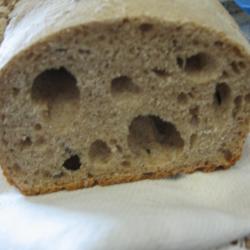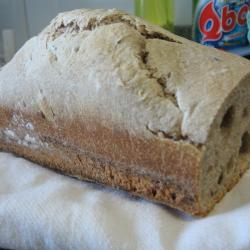
Hi people,
After 1 year of unsuccessful attempts at soudough baking I could fynally..... fail again!
Honestly, I don´t get it, the starter is raising as it is expected, but the bread turns out to be too compact and pale, and it has enormous holes in it. I´ll post some pictures of the starter and the bread for you to laugh of it as I did when it came out of the oven!
Category:


Replies
Hello Dunia,
Don't depair, we have all had our 'duds'. Fortunately, even though they might look a bit funny, I have never really heard of one that was not edible.
If you could give the recipe that you used and details of the procedure that you followed from dough starter feeding, dough preparation, proving, shaping and baking, we might have a better chance of making sensible suggestions since your 'problem' might start anywhere in the process.
The other thing that I usually suggest as well is that you should make several loaves using the same recipe until you can do it easily - sometimes as you get practice, problems resolve themselves as you get to understand the procedures and dough characteristics better.
Keep on bakin'
Farinam
Ok, here it goes. I would try that recipe from the reply to my post, when I asked a easy recipe to begin, but it didn´t have the directions for me to follow, so I just took one that had it. I found the recipe of the following link, and decided to try it, since it didn´t seem very difficult and included an 100% hydration starter, as the one (I believe) I have... (link: http://www.sourdough.com/recipes/rye-loaf-750g). While I was organizing the ingredients, I was thinking if it was necessary to feed the starter right before the preparation, but since I had done that 12 hours before starting preparation (for normal feeding), and it had doubled in size, I didn´t REfed again before mixing things (AND the recipe, as you can see, didn´t call for that). Either way, I just followed the recipe as it is written.
Again, sorry for the bad english....
http://sourdough.com/blog/sourdom/beginners-blog-slash-and-burn-hopefull...
Hello Dunia,
The recipe and method that you followed should be OK though I think the relatively high rye content could make it more difficult than it first seems. I think that the simpler ingredients and the detailed methods included on this page might be better suited.
If you haven't already read them, SourDom has a series of about five tutorials for beginners in which he imparts all sorts of useful information.
Let us know how you go.
Farinam
First, don't give up. It took me about 6 tries before I got anything that wasn't embarrassing. It has taken me 6 months to finally get consistent excellent results.
At first for me, I was always too impatient. Now, for me making a sourdough is really about a 10-12 hour process from start to finish (and maybe 12 hours in the refirgerator too!). At first I was always too impatient and tried to get bread out of the oven after 6 hours. I got pale, stiff, embarrassing bread.
One last thing...every step is important...even the shaping of the bread will affect the texture of the final product. The temperature of the oven too! Anyway, I have gone through a lot of flour before I can finally say...."Yeah, I'm good at baking sourdough."
Thanks again, I´ll keep that in mind.
: )
Hi Dunia, I totally agree with what the other people have said. It took some about 6 attempts as well to get a bread that was good to eat. The only thing that I might add is to make sure that you use your starter when it is ripe. IF you have been baking this bread for such a long time your starter is what? about 6-12 Months old? Or is it a new starter? If so how long have you been feeding it?
Do you keep it in the fridge before baking?
I keep mine in the fridge before baking, take it out about24 hours before making bread, let it come to room temperature, feed it 50/50 flour and water ( I do 50gr of flour then 50 grams of water). The starter will take about 8 -12 hours to rise to double its size. Then the next morning I discard about half and feed it 100gr of flour and 100gr of water. This second time around it will take only 6 hrs to rise to double its size. Once it is at double its size (peak) that is when start the process of making my bread. When I bake a lot and keep my starter on the bench it will only take 4 hours to get to the Peak, so I have to keep an eye on it, to use it at the peak.
One time I had done all these steps but forgot about the starter and because I was going to a friends place and promised them some bread, I still used it, even though it can gone past the peak and was going down again (down about 1/3). The result was bread that was very compact and had big holes in it. Now I don't know if that is what is going on with your process, but I thought I would mention it.
let us know how you get on. By the way where are you from?
Kind regards Alex
Hi Dunai,
All of the folks who responded are offering some good pointers. While there is an ideal moment to use a newly fed starter, your bread can still turn out okay if you let the starter sit for longer than that.
One more thing you might want to think about is how you are handling the dough when doing the stretch and folds, and also when doing the final shaping. when I lay out the dough for the stretch & fold, I first stretch it out to a rectangle, and then use my fingers to press the bigger air pockets out of the dough. When I am finished with this, the dough looks dimpled all over. Then I proceed to fold or shape.
In the finsihed loaf, I find that the huge holes are gone, and the crumb has smaller but more uniform holes.
Give it a try if you like, and see if that gives you a loaf that you are proud of.
Good luck!
---->Joel
Slightly wetter dough might give less density also, and lighter flour. :)
Thanks for the add I am new at this and my starter is only at day nine ....I have a starter that is a month old but so far no great result .. house bricks would be a good discription ...lol .. the starter recipe I am using comes from Udemy.com.. so will be making my first loaf with this on Sunday ...
Hello Lady-Annie,
I think we have all made our house-bricks but one of the secrets is not to give up and keep practicing and observing what is going on. The other thing is not to try to rush things and in actual fact it is probably better to let things go on longer than you think so that you will get to see what happens. Once you know what happens you can cut back next time. It is easier to cut back after you have gone too far thatn to extend when you haven't gone far enough.
It will depend on temperature and the activity of your starter but you could be looking at up to eight hours from preparing dough to baking though it is possible to adjust this with some form of temperature control. Have a read of SourDom's Beginners Blog on this site and he will give you some good insights to methods and timings and how to judge the various stages.
Goos luck with your projects.
Farinam